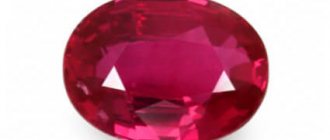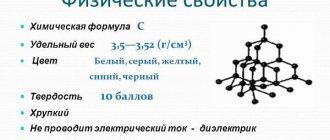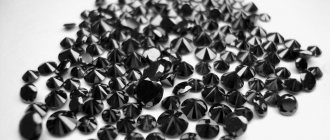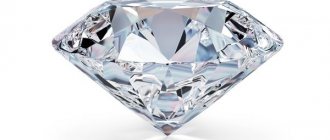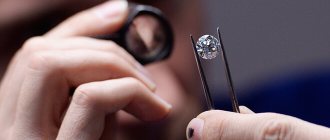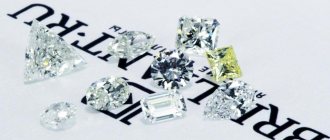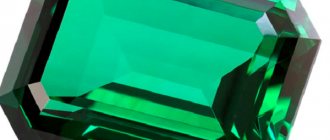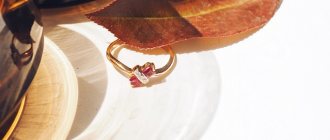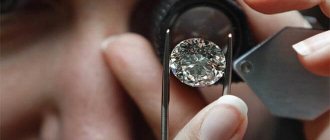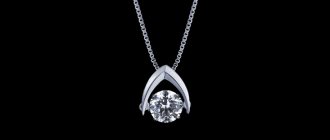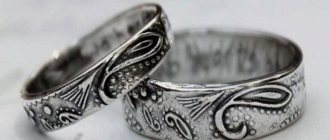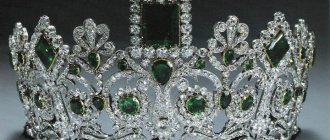If you have purchased a piece of diamond jewelry and doubt that it is real, or are just planning to purchase it, it will not hurt to know how authenticity is checked. Affordable home tests will dispel or confirm suspicions and reduce the likelihood that under the guise and price of a diamond you will be sold a sparkling cheap fake.
What does a real diamond look like?
The most popular, prestigious, expensive and promoted stone is the diamond. Every woman (and some men) dreams of him. The natural raw material for making diamonds is diamonds. They are mined from deposits.
Such crystals have an inconspicuous appearance and irregular configuration. For an ignorant person, this is an inconspicuous stone that does not at all resemble a luxurious sparkling diamond.
A diamond is made of pure carbon, but sometimes it contains impurities of other substances that were around while it was in the ground. The fewer foreign inclusions found in a diamond, the higher its purity. Samples without large inclusions, defects, or cracks are sent to jewelers for processing. To become a full-fledged diamond, the diamond must weigh at least 0.29 carats.
The content of other chemical elements gives diamonds their color. Today, pink, yellow, and blue diamonds are in fashion, but colorless specimens are most valued.
After the jeweler cuts, grinds and polishes the diamond, it becomes a luxurious diamond with the following properties:
- Unsurpassed hardness. The diamond can withstand pressure of several tons. It cannot be scratched. Only another diamond can leave a mark on it. Its hardness is 10/10 on the Moss scale (for gold this figure is 3/10).
- Fragility. "A Girl's Best Friend" doesn't pull any punches. If you hit a diamond hard with a hammer, the stone will crack just like glass.
- High refractive index. When light hits a diamond, the stone flashes with myriads of silvery sparks. Due to strong refraction, the diamond does not shimmer with multi-colored highlights, but scatters a noble glow consisting of shades of gray.
- Dispersion or “play of the stone”. According to this indicator, the diamond is a recognized record holder. No other gemstone produces such intense shine.
- Luminescence. In ultraviolet light, the diamond glows with a soft blue glow.
- Resistant to acids (except hydrofluoric acid).
- Withstands high temperatures. The stone will burn if heated to 850 °C or higher.
- Does not change color or fade. And in a hundred years it will shimmer and shine.
Information about the main qualities of a diamond will help you independently distinguish a diamond from a semi-precious stone if you cannot check it with a jeweler.
Real diamonds look like this:
- Faceted stone. If it is unframed, it is accompanied by a certificate confirming its authenticity and quality. If the stone is inserted into the product, then the name (br), clarity (evaluated by four parameters, most often it is 2/4), carat (for example: 1 ct), cut type (cr - round, o - oval) is written on the tag and so on).
- Shimmers and shines. In the light, the stone sparkles with all its facets. This is its distinctive property, which is reflected in the name. Translated from French, “brilliant” means brilliant.
- Has an invisible cut. If it is inserted into a piece of jewelry, it is impossible to see its top and cut angles.
- Sparkles in shades of grey.
- Does not wobble, securely fixed in the product.
- Set in gold or platinum.
- Doesn't shine through. In a properly cut diamond, the bottom is not visible.
- There must be a hole under the stone. The lower part of the diamond (pavilion) should not come into close contact with the metal, because refraction is determined by the stone-air parameter, not the stone-metal parameter.
- Store-bought diamonds often have a round shape and a classic cut of 57 facets.
A black diamond is expensive, but looks less impressive.
It does not play in the light, but only gives an aristocratic glow from the dark surface.
Why do diamonds fluoresce under UV light?
The ability of diamonds to luminesce when exposed to ultraviolet light is caused by two factors:
- defects in the diamond crystal lattice;
- the presence of impurities in the structure of the stone - chemical substances with incomplete electron shells of atoms (the so-called luminogen elements).
However, if we answer the question of whether diamonds glow in ultraviolet light, it should be noted that the purest (highest quality) diamonds do not fluoresce in UV rays, which is due to the uniformity of their composition and the absence of defects at the molecular level.
What can it be easily confused with?
A diamond in a piece can be replaced not only at the jewelry manufacturing stage, but also in a jewelry salon. Counterfeits have been used for a long time; they existed back in 1920. In the past, they tried to pass off radiant or corundite as a diamond. Later, other cheap imitators of the “royal stone” appeared - strontium, rutile, titanium, white sapphire.
Modern technologies have made it possible to create artificial stones that are absolutely identical in appearance to processed diamonds. They are made of such high quality that even testers are not always able to recognize a glass diamond.
The properties of a gemstone are best imitated by the following fakes:
- Cubic zirconia (zircon) is a synthetic stone, zirconium dioxide. It was invented by Soviet physicists in the 70s of the last century. Since then, products with cubic zirconia have been sold all over the world. Zircon shines almost as brightly as a diamond, but with iridescent highlights. It can be transparent (the most expensive) and colored. Currently, cubic zirconia is produced in six main colors.
- Moissanite is carborundum, the most accurate artificial copy of a diamond. It is 90% similar to the precious “prototype”. Its shine is even more intense than that of the “king of stones”. It is impossible to identify moissanite by eye; even an experienced jeweler can make a mistake. Not all testers are up to this task.
- Rock crystal is similar in appearance to a diamond, and after cutting it acquires a dazzling shine. You can recognize an imitation by the following characteristics: rock crystal is set in silver, less often - in gold, a diamond is set only in platinum and gold. Glue is often used to fix crystal, but this is not done when working with diamonds.
The following are also sold under the guise of a processed diamond:
- white topaz;
- yttrium aluminum garnet;
- leucosapphire;
- white beryl;
- artificial diamond;
- transparent spinel;
- rhinestones (ornamental stones made of glass);
- combinations of synthesized stones.
Cut quality
The quality of the cut determines the “game” of the stone – the ability to sparkle with all sorts of colors of the rainbow. The more precise the proportions and angles between the facets, the better the quality of the cut and the “game.” The cut group is determined by the proportions and quality of polishing of the diamond. When determining the cut group, attention is paid to deviations from ideal symmetry and proportions; they greatly affect the appearance of the stone. There are 5 cut groups:
- Excellent
- excellent. - Very good
- very good. - Good
- good. - Fair
- satisfactory. - Poor
- bad.
Professional authentication methods
A purchased diamond can be checked for authenticity (for a fee) by a jeweler in a workshop or salon that sells items made of precious metals. For express analysis, a diamond detector is used. The check takes 8-10 minutes.
Outdated models of such devices only examine the thermal conductivity of the mineral, and therefore do not always provide reliable information about the authenticity of the stone. This tester will not help identify moissanite because it has the same thermal conductivity as a diamond.
Professional jewelers who specialize in working with diamonds use an advanced diamond authentication tester. He studies the refraction of light. In this indicator, moissanite is ahead of diamond, which makes it possible to immediately detect a fake diamond.
The diamond tester only tests cut crystals.
Such a device will not be able to examine a rough diamond and determine its authenticity.
The most accurate result is guaranteed by the use of three sensors that analyze reflectance, luminescence and photoluminescence. Inexpensive diamond testers give a 50/50 result - “either a diamond or not.” Such devices cannot be trusted.
Experienced jewelers are able to identify a diamond without the use of technology. To distinguish a diamond from a semi-precious imitation or glass, they examine the stone using the following criteria.
Light
Diamonds have special optical properties that are easy to detect by visual inspection in the light or using a magnifying glass with 10x magnification:
- They give the same intense shine not only from above, but from all sides.
- In directed light they scatter with silvery reflections.
- Opaque. Light falling on a smooth surface of a stone is reflected from the edges.
If you look at the stone from above, you will see many iridescences and a tiny dot in the middle - a thorn. There is a simple way to check this property: draw a letter on a piece of paper and try to see it through the mineral. If it's a diamond, you won't see anything.
Comparison
To distinguish a genuine diamond from other stones, it is enough to know a few basic differences:
- A real diamond is a natural formation; it is never absolutely pure. Looking at it through a magnifying glass, you will definitely see the smallest imperfections in it. If the stone has a perfectly smooth and even surface, you have an artificial analogue.
- A cut diamond sparkles and shimmers so much that other stones appear inexpressive and faded against its background. However, it is difficult to distinguish a stone by this indicator. Some artificially synthesized minerals (moissanite) can sparkle no worse than diamonds.
- Diamond is a record holder for strength; after processing, its edges become sharp and clear. In glass imitators they are less sharp and somewhat rounded.
Distortion
A natural diamond does not exhibit double refraction. If you shine light on it and look through a magnifying glass, you will notice that a direct light beam is reflected from its edges. It never splits in two or deviates to the side. If it turns out that one face reflects two rays (flat and inclined), it is cubic zirconia.
Weight
A reliable method that jewelers have long used to assess the authenticity of diamonds is weighing on a carat scale. It is based on the fact that the size of the stone must correspond to the carat weight. It is known that zircons are half as heavy as diamonds, so a fake will be immediately detected.
The weight of precious stones is expressed in carats: 1 ct = 0.2 g. For example: small diamond: 2.0 mm = 0.029 ct; medium: 3.0 mm = 0.098 ct, 5 mm = 0.450 ct; large: 6.5 mm = 1.010 ct, giant at 9 mm = 2.59 ct.
Frame
A diamond is an elite stone, so jewelers are very meticulous about setting it in a product. Depending on the frame, it appears larger or smaller. The frame allows you to hide minor defects and foreign inclusions. Metal, setting and setting are factors that will help distinguish a real cut diamond from a budget fake.
When purchasing diamond jewelry, check it for compliance with the following rules:
- High purity diamonds are usually set in platinum or white gold. It is believed that white metal does not distract attention from the luxurious stone, but only highlights the brilliance and luxury.
- Colored diamonds are set in red or yellow gold. It harmoniously combines with fantasy stone.
- Silver frames are not elite enough and expensive. Cut diamonds are inserted only into jewelry made of precious metals - gold and platinum.
- A diamond is set in one of three ways. A popular type of fastening is using tiny metal claws (prongs). Blind fastening is a reliable method of encrusting products with diamonds, but it visually reduces the size of the mineral. Much less common is corner setting, when the stone is inserted not into a prepared socket, but into the metal plate itself. Other fastening methods are also used, but the underside of the stone is always left open. If the stone is fastened carelessly (loose, too recessed into the frame, the distances between adjacent paws are not the same) - it is not real. Diamonds are not treated this way.
- No adhesive setting is used for natural stones. Artificial crystals are “planted” on the glue.
To make sure the stone is set in platinum or white gold and not silver, check the hallmark of the metal.
Ultraviolet
A more accurate method that will distinguish a diamond or a cut diamond from inexpensive counterparts of artificial origin is based on the use of ultraviolet light. If you have a quartz medical or ultraviolet lamp at home (for drying gel polish), shine it on the stone and evaluate the result:
- Under ultraviolet light, diamonds emit a bluish glow.
- If the stone does not react to exposure to UV rays, it is glass or another imitation diamond.
- The appearance of a green, gray or yellow glow indicates moissanite.
Diamonds have another specific feature - they are invisible in X-rays. But this property cannot be tested at home.
Purity
The purity of a diamond is checked by observing the stone through a magnifying glass with 10x magnification or a microscope. The purity group is lower, the more defects the diamonds have: internal inclusions, cracks, external chips, and so on. The purity group is also influenced by the position of the defect, its size, shape and color. There are 11 purity groups:
- Flawless
(FL) – without any internal or surface inclusions. - Internally Flawless
(IF) - without internal inclusions. Minor surface defects are acceptable. - Very very slightly included
(VVS1, VVS2) – with inclusions of the smallest size. - Very slightly included
(VS1, VS2) – with very minor inclusions. - Slightly included
(SI1, SI2) – with minor inclusions. - Included
(I1, I2, I3) – with large inclusions.
How to distinguish a diamond from a fake at home
To independently verify the authenticity of a stone, you can use several proven home methods, some of which are also applicable in a jewelry salon.
To get an accurate result, arm yourself with a flashlight and sandpaper. Prepare a magnifying glass with at least 10x magnification. You will need a piece of soft, clean and dry cloth, water and vegetable oil.
It is better to carry out a home examination on a sunny day.
Water
Using water, you can instantly find out whether or not a diamond is set in a ring, earrings or other purchased jewelry. Sprinkle a couple of drops of water onto the top flat surface of the stone. Poke them with a needle. If the drops have not changed, then you were not deceived. On the surface of artificial stones they will disintegrate into small fractions.
To get a more visual picture, take vegetable oil rather than water, put it in a pipette and drop it onto the stone. If the drop remains intact, this will prove the authenticity of the mineral; if it splits into parts, this is a negative sign. They sold you a fake under the guise of a diamond.
Breath
Natural diamonds do not become covered with “perspiration” even at high humidity. Knowing this feature, you can instantly check the stone not only at home, but also in the store before purchasing the product.
To do this, wipe the crystal with a soft flannel cloth and then breathe on it for 2-3 seconds. If it remains dry and shiny, it is a diamond. The fake will fog up, become damp and dull.
Price
Cost is an essential parameter for evaluating a diamond.
Diamonds are the most expensive gemstones. They can't be cheap.
If you are offered an inexpensive diamond ring (at a discount), do not give in to such temptation, otherwise you will invest your money in a worthless thing.
The price of a diamond is calculated from such indicators as the type and quality of cut, carat weight, clarity, color rarity, and current prices on the world market. The cost of such stones directly depends on the size. A 1-carat diamond costs 15-20 times more than a scattering of tiny diamonds with the same total weight.
Scratches
Diamond is a super-strong mineral. It is impossible to scratch it. To ensure that a piece of jewelry is a real diamond, rub the surface of the stone with sandpaper or corundum. If there are no traces left, this is truly the “king of stones.” If roughness or scratches appear on the surface, this is just a skillfully executed fake.
Use this method very carefully to avoid scratching the gold setting of the jewelry. Do not test the hardness of a stone using another diamond; it will easily damage its “brother.”
Prohibited Methods
If you don’t mind ruining a stone imitation of a cut diamond, then you can determine the authenticity of a diamond using cruel methods:
- Keep the stone in the flame of an open fire for 3-4 seconds. If it stays the same, it's a diamond. Moissanite will change color to green, and the original color will not be restored. It will be hopelessly spoiled.
- Drop the crystal into hydrochloric acid. If it is a linden tree, white streaks will form on it. It will no longer be possible to remove these marks. A real diamond will not suffer at all from such testing.
- If you suspect zirconium, lightly run a diamond pencil over the stone. This tool will leave a distinct mark on the semi-precious stone.
When performing this test, do not apply excessive force, otherwise the stone will crack.
The authenticity of a diamond can only be determined using such barbaric methods at home, after it has already been purchased. In a jewelry salon, no one will allow you to throw it into acid or burn it in fire. These testing methods are not suitable for set stones (due to the risk of damaging the jewellery).
Field test of Diamond Inspectors
08/06/2021 Gemology 746
Alexey Lagutenkov
Website: Go
Independent expert gemologist. Academic titles: GG GIA (Chartered Gemologist, Gemological Institute of America), AJP GIA (Accredited Jewelry Professional of the Gemological Institute of America), MBA Kingston University UK (Master of Business Administration from Kingston University UK).
Author of the best-selling book "Gemstones".
Other expert publications:
- Evaluation of colored jewelry stones. Introduction to the "World of Color" from GemGuide
- Synthetic Diamonds 2020
- How to evaluate a gem or a game without rules
- Let's talk about the new GOST for diamonds
- Sapphirite Madness
July 2021 turned out to be not only hot, but also very interesting! Thanks to Alrosa Technology, two of their devices, “Diamond Inspector” and “Diamond Inspector View” (Photo 1), came into my hands. We did not stipulate any special operating conditions for the devices, other than not to drop or disassemble the devices, and also not to scratch swear words on the case. Among other things, this was a completely free, non-commercial trial for which I did not charge a penny. In exchange for this, I received the right to write about this family of devices completely unbiased, without advertising enthusiasm and praise. Needless to say, this is a rather bold step on the part of Alrosa Technology, which speaks of their confidence in the quality of the device.
Photo 1. “Diamond Inspector” (left) and “Diamond Inspector View” (right). Alrosa Technology.
I have already written about the “Diamond Inspector”, however, it is one thing to conduct a theoretical conversation that, supposedly, there is such a device in nature and its hypothetical characteristics, in general, are probably not bad. It’s a completely different matter to work with such equipment live! I am also very grateful to the Russian company IQDiamonds, which provided free samples of laboratory-grown diamonds (from the English Laboratory Grown Diamonds or LGD) and jewelry with them for honest and independent tests.
Let’s say right away that “Diamond Inspector” and “Diamond Inspector View” are not “pocket devices. They can be called “portable”, but not pocket-sized. Comparing them in size and weight to, say, the Smart Pro or Veritas Gemtrue makes no sense! Domestic high-tech devices are frankly larger in size and weight. Is this justified? Let's watch!
First of all, I was interested in the fact that the Diamond Inspector supposedly uses not a simple set of filters and UV LEDs, like most pocket-sized foreign inexpensive devices, but three real, full-fledged spectrometers: Raman, UV and visible range.
It is impossible to verify the actual presence of all three measurement methods from a photograph and one appearance of the device. Only the gods know what is inside that black box. Right? Not so in the case of The Inspector. Once you connect this device to your computer via USB, install the software and press a button on the device, after a couple of seconds an Excel table file opens on your PC with three graphs: “Ultraviolet absorption spectra” in the range from 199.5 to 343.5 nm, “Visible fluorescence” from 399.1 up to 664.5 nm and “Raman Spectroscopy” from 541.8 to 664.5 nm. In addition, during operation, you can hear the operation of some mechanics inside the device. Apparently, the “Inspector” physically moves certain filters inside itself during the measurement.
If in diamonds and jewelry business you are only interested in the price and “to whom to sell?”, then in this case the “Inspector” has an indicator on the front panel that shows in Russian or English: “Natural diamond”, “Refined”, “Type IIa” (IaB)” (this is how LGD diamonds are grown in a laboratory), “Malinger” or “Research Required!” True, I will hardly ever be able to understand such incurious people!
“Advanced” analysis of rough and polished diamonds allows you to look at their jewelry essence from a completely different perspective! If previously a gemologist was “blind” and judged loose diamonds or stones in a product only by indirect methods, now any specialist can gain “spectral vision”!
However, let’s get down to describing personal impressions of working with the devices!
It is unlikely that anyone in our time will have big problems identifying cubic zirconia or moissanite. These simulators are relatively easily caught by all kinds of pocket testers. Their difference from diamonds can be seen under a microscope. In the end, you can always measure the specific gravity: cubic zirconias are much “heavier” than diamonds, while moissanites, on the contrary, are up to 10% lighter. However, these are indirect methods. What if, say, an expert gemologist has to prove the fact of stone substitution in court? Tell the judge that the pocket tester “beeps” on diamonds, but in our case it “does not beep” and, therefore, the sample being examined is not a diamond? What if you come across not cubic zirconia, but moissanite with low electrical conductivity, which behaves on the simplest devices like a full-fledged diamond and “squeaks” correctly where it is required?
I conducted my first study of Diamond Inspector on malingerers. At my disposal were 22 cubic zirconia from different suppliers and 31 moissanite. Cubic zirconia and moissanites turned out to have uniquely definable Raman spectra. Peaks are characteristic of cubic zirconia at 545 and 548 nm (Photo 2), and for moissanites at 555 and 560 nm (Photo 3). For comparison, natural and synthetic diamonds have a pronounced peak at 573 nm (Photo 4).
Photo 2. Raman spectrum of cubic zirconia
Photo 3. Raman spectrum of moissanites
Photo 4. Raman spectrum of natural diamonds
The presence of a Raman spectrometer in the Inspector, naturally, caused an irresistible desire to test colored stones as well. Unfortunately, nothing came of this idea. In some cases, too strong luminescence “overwhelmed” the Raman readings; in other cases, the spectrum turned out to be insignificant. In all cases, the “Inspector” indicator confidently showed “Sham”, and the spectra of some stones are shown in (Photo 5).
Photo 5. Raman spectra of pink spinel, pink sapphire and greenish-blue apatite obtained using Diamond Inspector from Alrosa Technology
Perhaps the experience of working with the device on non-diamonds was one of the simplest phases of testing. It was easier to work with colorless and almost colorless natural and laboratory-grown diamonds in the DJ GIA color range.
Thanks to a Moscow pawnshop, who asked not to be named, I had 7 natural, almost colorless diamonds at my disposal for research, weighing from 0.03 to 0.21 ct, FJ color groups.
IQDiamonds provided 15 LGDs grown using HPHT and CVD technologies. On all these stones, the “Inspector” did not make a single mistake, 100% confidently distinguishing laboratory-grown stones from natural ones. At this stage of research, the second device from Alrosa Technology, Diamond Inspector View, brought noticeable benefits.
This device can show fluorescence in long-wave 365 nm and short-wave 254 nm ultraviolet. A distinctive feature of “Inspector View” is the presence of a potentiometer that allows you to adjust the intensity of UV radiation, as well as the presence of a “Phosphorescence” button, which allows you to instantly turn off any lighting and observe the phenomenon of phosphorescence, which appears only in laboratory-grown diamonds, when after irradiation with ultraviolet light , these stones continue to glow on their own for some time in complete darkness. The fact of phosphorescence quite often indicates the laboratory origin of a diamond, with a high probability of being grown using HPHT technology. Perhaps this was one of the most beautiful phases of research into the operation of devices!
Most natural diamonds exhibited typical fluorescence: a moderate bluish-blue in the long-UV and a much weaker, greenish-blue in the long-wave. There were no non-fluorescent natural stones in my sample.
Photo 6. Fluorescence of LGD in long and short UV, obtained using Diamond Inspector View from Alrosa Technology
The situation with LGD turned out to be much more interesting. If the CVD diamond looked rather boring in Inspector View, showing no activity in the UV, then the HPHT more than compensated for all my curiosity! For example, the cross pendant (Photo 6) and one of the colorless diamonds showed amazingly long phosphorescence.
Photo 7. Diamond fluorescence in long- and short-wave UV
The next stage of testing was slightly beyond the scope of the documented capabilities of the Inspector, but, as they say, when else will I get my hands on the Raman? The pawnshop provided me with an additional 16 diamonds of unknown origin, KU color group. Three stones from this sample interested me because the Veritas “Gemtrue” screener confidently identified them as natural diamonds, while the “Diamond Inspector” stubbornly insisted: “Investigation required!” The fluorescence of all three stones is approximately the same: a moderate dark blue in the long UV and a slightly more intense greenish-blue in the short wave (Photo 7).
Sample number one has a peak in the ultraviolet absorption spectrum at 257 - 288 nm, characteristic of synthetic diamonds (Photo 8).
Photo 8. Diamond Inspector's testimony for Sample N1
Photo 9. Diamond Inspector's testimony for Sample N2
Photo 10. Diamond Inspector's testimony for Sample N3
Sample two shows a less pronounced peak in the same spectrum at 263 – 281 nm (Photo 9).
Sample number three is the most interesting (Photo 10). It does not have characteristic peaks in the ultraviolet absorption spectrum, but in the Raman spectrum a peak at 656 nm is clearly visible. If you open the book by R.A. Khmelnitsky “Introduction to Diamond Gemology” on page 109, then you can read the following: “2.4 The presence of nickel optical centers (658 and 883 - 884 nm) indicates an HPHT crystal.” According to Dr. V.G. Vince, the peak in the Raman spectrum at 656 nm is a band of impurity nickel, which indicates that this is a diamond grown in the HPHT laboratory, obtained in the Fe-Ni-C + Ti system.
Thus, all three dubious diamonds, which are identified as natural by the SmartPro and Veritas “Gemtrue” screeners, look dubious to the Diamond Inspector and are most likely synthetic stones.
The documented, “permitted according to instructions” capabilities of Diamond Inspectors ended there. Alrosa Technology categorically does not recommend experimenting with fancy diamonds, since the measurement results will obviously be incorrect. However, when you have fancy blue, yellow and red LGD samples from IQDiamonds on hand, it's simply a sin to miss this opportunity!
Fancy Vivid Yellow HPHT 2.07 carat (Photo 11), according to the certificate, has the characteristics of Fancy Vivid Yellow SI2. No peculiarities were noticed about him. Raman showed a peak at 573 nm (Photo 12), UV and visible fluorescence absorption spectra are not representative. The stone turned out to be absolutely indifferent to long- and short-wave ultraviolet radiation and did not show any visible fluorescence. In this case, using the “Inspector” you can make sure that it is definitely a diamond, but you will not be able to establish the nature of its origin.
Photo 11. Fancy yellow FVY SI2 laboratory grown HPHT diamond, weighing 2.07 carats. Provided by IQDiamond.
Photo 12. Diamond Inspector readings for HPHT FVY 2.07ct
Next, fancy blue diamonds were tested. The first sample is a Fancy Blue VVS2 HPHT diamond, weighing 0.8 kt, cushion cut (Photo 13). The inspector identified it as a “natural diamond,” which cannot be blamed on the device. On the Raman spectrum we observe the already familiar 573 nm (Photo 14). I have no explanation for the peak at 217 nm in the fluorescence absorption spectrum and 447 nm in the visible fluorescence graph. With the help of Diamond Inspector View, it was possible to establish that the stone is absolutely neutral to both ultraviolet ranges.
Photo 13. Fancy blue FB VVS2 laboratory grown HPHT diamond, weighing 0.8 carats. Provided by IQDiamond.
Photo 14. Diamond Inspector readings for HPHT FB 0.8ct
The second sample is synthetic Fancy Blue SI1 0.82 kt, the production process of which is unknown. There is no information whether it was created using HPHT or CVD (Photo 15). The "Inspector" identified it as a "Natural Diamond". Peak 573nm on Raman (Photo 16) and again a complete absence of fluorescence in Inspector View.
Photo 15 Fancy blue FB SI1 laboratory grown HPHT diamond, weighing 0.82 carats. Provided by IQDiamond.
Photo 16. Diamond Inspector readings for HPHT FB 0.82ct
Finally, the last guest is a complex deep red diamond weighing 0.53 ct (Photo 17). This stone was refined in Novosibirsk using the patented Multistep technology, the rights to which belong to Velman LLC and V.G. Vince. As a result of four stages of refining, the yellow-brown LGD turned into a beautiful diamond of a rare red hue.
Photo 17. Fancy red FR laboratory grown HPHT diamond, weighing 0.52 carats. Characteristics not defined. Provided by IQDiamond.
Photo 18. Diamond Inspector readings for HPHT FR 0.52ct
Photo 19. Fluorescence HPHT FR 0.52ct in “Diamond Inspector View”
Red diamonds go very far beyond the competence of the Diamond Inspector, so the device identified this stone as a “Sham”. From the graphs it was possible to remove only the Raman spectrum, which is absolutely unremarkable (Photo 18). The diamond exhibits bright red fluorescence in both ultraviolet ranges (Photo 19).
Alrosa Technology specialist Elizaveta Volkova explained the behavior of a red diamond when examining it with the help of the Diamond Inspector: “The situation, in principle, applies to all red diamonds. UV excites their own red glow in them, which falls on the red region of visible light. The ends of this “mound” of fluorescence stretching to the left and right also overlap that part of the spectrum where the Raman peak of all diamonds is usually located. If this fluorescence is more intense than the Raman peak, or if it extends further towards the UV, then it will simply cover it. In this case, our device does not see the emission at 572 - 573 nm and, quite reasonably, decides that the material under study is a simulator. This is exactly what happened with the red stone you tested. If you look closely at the last graph, you will notice that the fluorescence is so intense that it completely covers this peak.”
What conclusions can be drawn from this small study?
The combination of the Diamond Inspector and Diamond Inspector View devices allows for little money, about $7,500 dollars, to determine the nature of origin (natural, synthesized in the LGD laboratory) of any colorless and almost colorless diamond in the GIA DJ color nomenclature. Without additional effort and measurements, “Inspector” quickly identifies the most popular simulators. Despite its fairly large size, the Inspector consumes surprisingly little electricity. When powered by a power bank and almost continuously used for a week, the battery was discharged by only 2%. "Inspector View" is good for adjusting the brightness of the UV flux. This makes it possible to observe fluorescence and phosphorescence even in those diamonds that have the “None” characteristic in the gemological report.
Among the shortcomings of the Inspector, it should be noted that the instructions are rather “poor”, which describes only the basic functions of the device, without the use of a computer. In the device description you will not find any descriptions of the spectra or explanations of where to look on these spectra. The main drawback of Inspector View is the loose tray, which can fall inside the device during transportation. Yes, this tray is easy to remove, but when this happens for the first time, the incident is, let’s say, frightening.
Some time ago, I wrote about the behavioral features of consumerism of generations Y and Z. One of these features is distrust of authorities and the desire to double-check everything “here and now.” If “baby boomers” do not even need to prove that the stone in the jewelry is a diamond, they take the seller’s word for it, then “millennials” and “zoomers” may demand proof. If you install “Inspectors” in a retail jewelry showroom, having previously printed and hung pictures of spectra on the wall, you can potentially attract the attention of new generations with a sort of “gadgetized, high-tech show.” Moreover, it does not matter at all whether the salon specializes in selling natural or laboratory-grown diamonds. In both cases, clients can be charmed by an abundance of evidence and scientific information.
(c) A.A. Lagutenkov 2021
Gallery
Authentication Tips
Some more useful information for those who decide to test a rough diamond on their own:
- You can verify the authenticity of the purchased stone in this way: lubricate its surface with vegetable fat and glue it to a window or other glass surface. A real diamond will not fall off, but an artificial one will immediately fall down. The described method is applicable only to unmounted minerals. If the diamond is in a ring or earrings, it will not stay on the glass and will fall under the weight of the metal.
- There is a common myth among people that a high-quality natural diamond is invisible in water. It is not true. No matter how transparent a diamond is, it will still be visible because its density is higher than that of water. But the dive test is still not useless. By lowering the stone into a glass of water, you can check its integrity. If it is glued together from two stones, then the border of the joint will be visible.
- A magnet will help you distinguish a synthetic diamond from a natural one. 90% of artificial crystals are attracted to it.
Only an independent gemologist can accurately distinguish a real diamond from a cheap synthetic fake and support his conclusions with a certificate. This examination is carried out in a special gemological laboratory. If we are talking about a stone weighing 1 carat or more, then it is better not to take risks and turn to professionals.
Modern imitation diamonds copy diamonds so accurately that an ordinary person without special training and expensive equipment will never detect a fake. There are different ways to find out whether a stone actually is an expensive diamond or an ordinary piece of glass, but most of these methods do not provide a 100% guarantee.
Color
Diamonds are divided into several categories based on color:
- Colorless.
Colorless stones are those without any tint visible to the naked eye. They are divided into 3 colors, which are designated D, E, F. - With yellow and brown tints.
Diamonds ranging from almost colorless G to clearly colored Z are considered yellowish and brownish. There are a total of 20 such color groups. - Fantasy.
Colored or fancy diamonds are considered to be bright yellow, bright brown, red, pink, green, blue, blue and purple stones. Fancy colored diamonds use their own color designation system. The shade and intensity of the color of the stones in it are described separately.
To determine the color group, diamonds are usually compared to standards.
